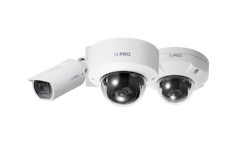New AI-enabled video surveillance cameras take analytics to the next level
Once Panasonic spun off its Panasonic i-PRO Sensing Solutions and subsequently transformed its global brand to i-PRO in 2020, there was a clear mandate echoed by President Bill Brennan and the executive product management team that the move was not simply a marketing change for the company but a shift in how it operates and approaches the market.
With the i-PRO structure, new solutions could direct the needs of mid-market clients with a flexible approach that would be faster to market.
To that end, i-PRO has just announced a new line of cameras that turn non-AI network cameras into AI smart devices. Using AI onsite learning, the X Series enables users to teach the camera about specific objects they want to monitor. With support for up to nine AI applications, it is the most powerful AI camera to date from i-PRO.
Taking Camera AI Beyond Security
The migration from analog to today’s high-end IP camera systems mirrors the advanced technology i-PRO has put into this new series and its strategic approach to future development, says Hiroshi (Huey) Sekiguchi, the CMO of i-PRO and EVP of i-PRO Americas.
“During the transition from analog to IP or digital video is not just video that we used to capture (images) through a coaxial cable and then we record and playback. There are so many ways to utilize video in terms of operations and security,” Sekiguchi says. “The use case is about more than on-prem versus the cloud. It's all more scale compared to the things that we used to use with analog. Our i-PRO team truly believes that the requirements and the possibilities of a camera are much higher than just providing a good picture quality camera.”
He points out that i-PRO has realized how best to leverage the assets of picture quality and stability and the company truly appreciates the end-user’s perspective on how video surveillance systems are being used and why they are deploying them.
“Capturing video is not the only thing the camera is asked to do. The camera is an eyeball out there in the field for operators to use as their eyes to detect incidents. Traditionally it's been (employed) more post-event, but wouldn’t it be better if we could detect incidents before they happen and potentially stop them?”
The “revolutionary” aspects of the new X Series cameras are two-fold, according to Sekiguchi. First, the cameras can drastically augment traditional cameras with AI capabilities using an innovative AI Processing Relay feature that allows clients to add AI capabilities to their existing, non-AI surveillance cameras. This capability includes cameras from other manufacturers, making them smarter and more efficient.
The most notable feature, however, is the camera’s new “on-site AI learning” capability that permits users to teach the camera to recognize custom objects they wish to identify and search for or track.
For example, operators could teach the camera to count forklifts passing through the camera’s field of view in a warehouse to provide new metrics for operational efficiency. A hospital could count ambulances arriving at the emergency room. The camera can even be taught to recognize a logo on a truck and send out an alert when it arrives at the loading dock.
The AI On-site Learning app has the capacity to auto-generate multiple training images at different luminance values saving operators valuable time while increasing detection accuracy.
“I call (this development) phase i-PRO without excuses; let’s just change our cameras to become an edge device with strong edge analytics. In fact, we don't call it a camera at all. It is a sensor with a lens that is armed with a microphone since we also do audio analytics,” says Sekiguchi, adding that at least 70% or more applications have installed cameras to watch people and vehicles. “We want a camera that’s going to provide preemptive data and analytics to help us deter and detect. Those are captured in video that we can only replay and playback and then verify. But now we can capture all that real-time data, which is called metadata, along with the video stream.
“Operators can quickly search or even detect if there have been built-in criteria that define what we want to detect. The operator can let the camera capture whatever what you want it to detect in the future and let it learn.”
Innovative Technology Drives AI
That aspect of an AI camera “learning on the job” moves the capabilities of the technology and the use-case for clients beyond current industry devices.
Most security consultants agree that end-users’ needs have shifted beyond a simple forensic and detection device to the camera acting as another sensor. More advanced deployments have morphed cameras into real-time data analytic tools where they can alter collected information to either deter and identify a threat vector or provide analysis for a marketing vector – all to be done in real-time.
“It’s typical for any surveillance manufacturer to have general use of VMD (video motion detector), right? AI has supported basic motion detection, so this is the next step. Now what we're doing with this camera series is saying, ‘Hey, how do we fine-tune it even further,’ ” explains Adam Lowenstein, Director of Product Management at i-PRO Americas, citing an example of taking vehicle monitoring beyond traditional cars and trucks to be able to track something like a forklift that isn’t recognized by a standard analytic, and training the AI in the camera to learn and understand new data points related to vehicle recognition.
“We’re not really talking about surveilling for security purposes. We're talking more about safety. We're talking about the process.
“What happened? When did that forklift go? It's supposed to go at 8:15 or 8:20, or the person driving it, were they wearing their protective vest or what color shirt was it? What attribute was it? Just that ability to custom customize the sensing of the object type and then still have all those attribute searches along with it, we think that's going to be unique and genuinely desired by our customer base. That takes us beyond an i-PRO and a Panasonic standpoint. This is where we see our ability to get into more infrastructure-type vertical customers. It's important because if I put this in and I improve or stop even one issue from occurring, what could that mean as savings to my business or process improvement?”
The just-released X Series utilizes the latest Ambarella AI SoC (CV52) to provide security professionals the benefits that edge AI cameras can offer to better protect assets, people and property while optimizing their operational efficiency and reducing the burden of routine monitoring. It includes 16 new camera models including eight bullet cameras, four interior domes, and four exterior domes with 2, 5, and 6MP options plus 4K models.
With Wide Dynamic Range (WDR) of up to 144dB and IR illumination to 70 meters, i-PRO says image performance is unparalleled in all conditions. Designed and manufactured in Japan, the NDAA-compliant cameras support the highest level of cybersecurity with FIPS 140-2 Level 3 certification, secure boot and GlobalSign digital certificates.
“At a high level, what we're doing is we're taking in an existing install of a surveillance solution and utilizing our exteriors to bring AI functionality while taking metadata from those streams. That's really what our goal is,” emphasizes Sekiguchi.
“You don't have to rip and replace your entire environment. If you have 4,000 cameras on site, but you need 100 of those to start doing some advanced analytics in critical infrastructure, an environment like a utility line, oil and gas or airport, and it's in a place where someone can't easily replace a camera with a new AI camera, we see this as a beneficial feature from a cost and time standpoint alone.”
Steve Lasky is a 34-year veteran of the security industry and an award-winning journalist. He is the editorial director of the Endeavor Business Media Security Group, which includes magazines Security Technology Executive, Security Business and Locksmith Ledger International and the top-rated website SecurityInfoWatch.com. Steve can be reached at [email protected]
About the Author
Steve Lasky
Editorial Director, Editor-in-Chief/Security Technology Executive
Steve Lasky is Editorial Director of the Endeavor Business Media Security Group, which includes SecurityInfoWatch.com, as well as Security Business, Security Technology Executive, and Locksmith Ledger magazines. He is also the host of the SecurityDNA podcast series. Reach him at [email protected].





